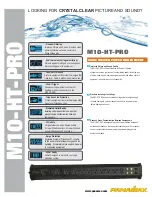
10-4
745 Transformer Management Relay
GE Power Management
10.3 GENERAL PRELIMINARY WORK
10 COMMISSIONING
10
10.3 GENERAL PRELIMINARY WORK
10.3.1 DESCRIPTION
1.
Review appropriate sections of this manual to familiarize yourself with the relay. Confidence in the commis-
sioning process comes with knowledge of the relay features and methods of applying settings.
2.
Verify the installation to ensure correct connections of all inputs and outputs.
3.
Review the relay settings and/or determine features and settings required for your installation. In large util-
ities a central group is often responsible for determining which relay features will be enabled and which
settings are appropriate. In a small utility or industrial user, the on-site technical person is responsible both
for the settings and also for the complete testing of the relay.
4.
Set the relay according to requirements. Ensure that the correct relay model has been installed. A sum-
mary table is available in this manual for users to record all the relay settings. When the testing is com-
pleted, users should verify the applied relay settings, and verify that all desired elements have been
enabled, using the 745PC program or the relay front panel.
5.
Verify that the relay rated AC current matches the CT secondary value.
6.
Verify that the relay rated AC voltage matches the VT secondary value.
7.
Verify that the relay rated frequency setting matches the power system frequency.
8.
Open all blocking switches so as not to issue an inadvertent trip signal to line breakers.
9.
Verify that the auxiliary supply matches relay nameplate. Turn the auxiliary supply ON.
10. Verify that all grounding connections are correctly made.
To facilitate testing it is recommended that all functions be initially set to Disabled. Every feature which will be
used in the application should be set per desired settings, enabled for the specific commissioning test for the
feature, then returned to Disabled at completion of its test. Each feature can then be tested without complica-
tions caused by operations of other features. At the completion of all commissioning tests all required features
are then Enabled.
It is necessary to keep track of modifications/changes made to settings during the course of
these commissioning steps and ensure that all settings are returned to the "in-service" values
at the end of the tests, prior to placing the relay into service.
CAUTION
Summary of Contents for 745 TRANSFORMER MANAGEMENT RELAY
Page 30: ...2 8 745 Transformer Management Relay GE Power Management 2 3 SECURITY 2 GETTING STARTED 2 ...
Page 210: ...7 36 745 Transformer Management Relay GE Power Management 7 2 BLOCK DIAGRAMS 7 SCHEME LOGIC 7 ...
Page 322: ...9 12 745 Transformer Management Relay GE Power Management 9 3 USING 745PC 9 745 PC SOFTWARE 9 ...
Page 396: ...A 4 745 Transformer Management Relay GE Power Management A 1 FIGURES AND TABLES APPENDIXA A ...
Page 400: ...C 2 745 Transformer Management Relay GE Power Management C 1 WARRANTY INFORMATION APPENDIXC C ...
Page 406: ...vi 745 Transformer Management Relay GE Power Management ...
Page 407: ...GE Power Management 745 Transformer Management Relay NOTES ...









































